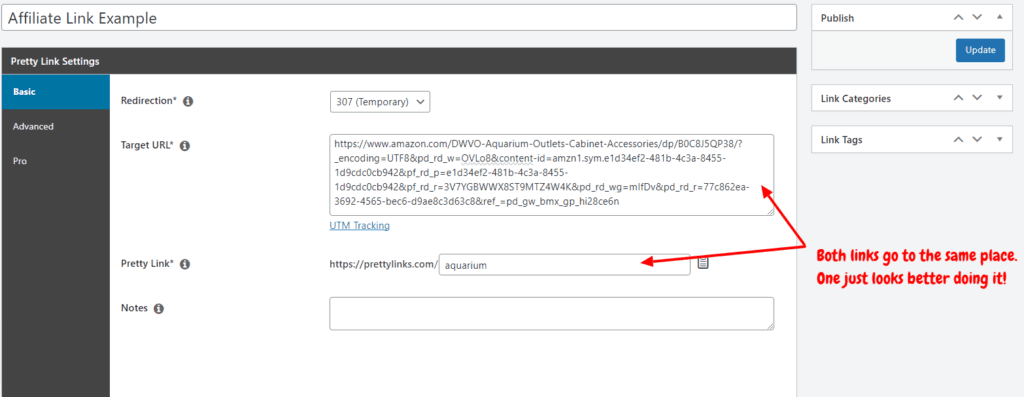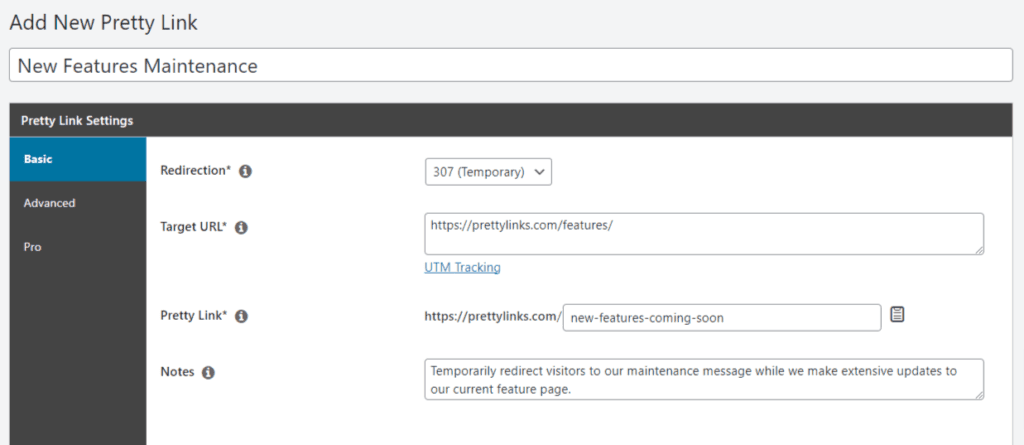3 razones para utilizar una redirección temporal en su sitio web (y cómo hacerlo)

Contenido
¿Se ha encontrado alguna vez en la situación de tener que redirigir a los visitantes de un sitio web de una página a otra, pero sólo durante un breve espacio de tiempo? Una redirección temporal es la solución.
Una redirección temporal hace exactamente lo que su nombre indica: lleva a los visitantes de una dirección web a otra, temporalmente. Hay un montón de razones por las que puede necesitar este truco en la manga, y una herramienta como Pretty Links puede ayudarle a configurar uno sin ningún problema.
So, let’s break it down. In this post, we’ll talk about what temporary redirects are, why they’re useful, and 3 common situations where they come in super handy. Plus, I’ll show you the ropes on how to use Pretty Links to make it happen. Let’s get started!
¿Qué es una redirección temporal? (y cuándo debe utilizarlo)
Los redireccionamientos son como los atajos en Internet. Te permiten utilizar diferentes caminos para llegar a la misma página web.
For example, as an affiliate marketer, you use redirects to tidy up messy affiliate links. Instead of sharing a long link that doesn’t look nice, you make a shorter one. When someone clicks on your shortened affiliate link, it still takes them to the same place as the messy link.

Los redireccionamientos facilitan la búsqueda y el intercambio en Internet.
Hay dos principales tipos de redireccionamientos: permanentes y temporales. Pero cuando se trata de aplicar una dentro de su propio sitioCada uno tiene una función específica.
A redirección permanente is similar to leaving a forwarding address with the postal service. It’s a signal to everyone (in this case, search engines), that your content has permanently relocated.
Por otro lado, una redirección temporal is like saying, “I’ve taken my content on a little vacation. But it’ll be back mejor que nunca antes de que te des cuenta.
Both redirect types guide visitors to your content’s “current place of residency” – whether that’s a new website or a temporary holding space (like a maintenance message page).
But here’s where it gets interesting. Temporary and permanent redirects have different interactions with search engines.
When there’s a temporary redirect in place, search engines keep peeking at the original address to check if it’s back in action. Once it’s up and running again, the original connection gets restored, and search engines happily continue exploring your content like nothing ever happened.
3 razones para utilizar redireccionamientos temporales en su sitio web
Now that we’ve got a clearer picture of how temporary redirects work, let’s explore a few scenarios for when incorporating them into your website strategy can be highly effective.
1. Aplicar pruebas A/B
When you’re working on your web pages, you might find yourself wondering if you’ve hit the bullseye with the best version. That’s where Pruebas A/B interviene para ayudarte.
Think of A/B testing as a friendly contest between two versions of the same web page. It’s like splitting your page’s visitors right down the middle – half of them get to check out version A, while the other half gets directed to version B.

Esto le permite jugar con diferentes elementos de diseño y comparar resultados importantes como las tasas de conversión, las tasas de rebote y el tiempo que los visitantes permanecen en la página.
Por ejemplo: puede descubrir que un botón de llamada a la acción consigue más clics que uno azul. O que dejar caer expositores de productos en un artículo de blog aporta mucha más pasta de comisiones.
La lista de cosas que puede probar en su sitio web es interminable. Pero tenga cuidado de no probar demasiadas cosas a la vez. Cuando se cambian varios elementos a la vez, puede ser difícil determinar qué cambio específico produjo un resultado mejor o peor.
2. Actualice su sitio web sin interrupciones
Say you’re doing more than just giving areas of your site a fresh coat of paint and it’s time for un cambio de imagen a gran escala. We’re talking a digital demolition! In this kind of website revamp, you’ll need to make sure you’ve got an “under construction” redirect in place.
This temporary redirect trick ensures that your virtual doors aren’t completely closed during maintenance. It’s more like telling your visitors, “Hey, we’re sprucing things up in here, but we’re not closed for business!”
This way, your online guests won’t be left wondering when your website will reopen. Instead, they get a warm welcome to a página de mantenimiento temporalque actúa como un marcador de posición mientras creas algo hermoso entre bastidores.

Fuente de la imagen
Además, los "inspectores" de los motores de búsqueda juegan limpio y dejan de husmear hasta que la redirección temporal se hace a un lado y la URL original vuelve a funcionar.
3. Crear una página sin afectar al SEO
Optimización de motores de búsqueda (SEO) es lo que ayuda a su sitio web a brillar en las páginas de resultados de los motores de búsqueda (SERPs). Por lo general, usted quiere que sus páginas web estén perfectamente preparadas para motores de búsqueda para explorar todos los rincones. Pero, de vez en cuando, puede que quieras poner un cartel de "No molestar".
For instance, if you’re in the initial stages of crafting a fresh new webpage. While it might be tempting to aim for the top of SEO rankings right away, it might not always be the wisest move for your website’s overall strategy.
Or let’s say you’re fine-tuning a web page based on valiosos comentarios you’ve received. You want the chance to polish things up without making a big show of it in search results.
While this technique is frequently used by developers, it’s also a smooth move for anyone making adjustments to their website. It gives you the power to decide when and how your web page interacts with search engines, allowing you to maintain a sense of control over your site’s performance.
Cómo puede ayudarle Pretty Links a implementar redireccionamientos temporales
Aunque el acortamiento de enlaces es la estrella del espectáculo con Pretty Links, nuestra herramienta cuenta con una serie de características adicionales, incluyendo opciones para redirecciones permanentes y temporales.
Con Pretty Links, configurar redireccionamientos temporales es muy sencillo. Para empezar, diríjase a Pretty Links > Añadir nuevo enlace en la parte izquierda del panel de control de WordPress.
Dé a su redirección de enlace bonita un título que ayude a definir su propósito. Si es necesario, también puede incluir detalles adicionales en la sección de notas para obtener más explicaciones:

A continuación, seleccione la opción tipo de redirección temporal you’d like to use. Pretty Links offers two options to consider:
- A Redirección 302: This redirect works like guiding your visitors to a different room in your house for a bit. It’s like saying, “Hey, for now, have a look at this other space.” But here’s the catch: you’re not really explaining why they’re being redirected. Just a word of caution, though – if you use this for an extended period, search engines might assume it’s a permanent switch.
- Una redirección 307: This redirect is more upfront and transparent. It’s like letting your visitors know, “I’m moving this page temporarily, but it’ll be right back in its original spot soon. Meanwhile, you can find it over here.” This redirect is your go-to when you’re shifting a page temporarily and you’re planning to bring it back. Your visitors stick with the original link since the change isn’t permanent. If you’re confident that the change will be short-lived, this is the redirect to go for on your website.
Below that, go ahead and enter the redirect URL (the destination where all the traffic will be rerouted) into the Target URL box. Then, in that Pretty Link box, here’s where you can have a little fun and give your redirect link a cool nickname.
This is the short link readers will remember, and you could even queue them in on what’s happening:

Just a heads-up: if you’ve already got a page on your WordPress site using the same short link slug, you’ll need to tweak that page’s web address. Pretty Links doesn’t like twinsies when it comes to web addresses.
Pero no te preocupes. Siempre puedes volver a cambiar el apodo una vez que la redirección temporal haya hecho su trabajo.
Una vez que todo esté en su lugar, simplemente haga clic en el botón "Actualizar", y su redirección estará lista para guiar su tráfico web en cualquier dirección que necesite.
Conclusión
Como ya hemos dicho, las redirecciones temporales pueden ser útiles por varias razones. ¡Afortunadamente, la configuración de estas redirecciones es sencilla cuando se utiliza una herramienta de gestión de enlaces como Pretty Links!
Hoy hemos repasado 3 razones para utilizar redireccionamientos temporales en su sitio. Para recapitular, que incluyen:
- Realización de pruebas A/B
- Actualice su sitio web sin interrupciones
- Crear una página sin afectar al SEO
¿Tiene alguna pregunta sobre los redireccionamientos temporales o sobre cómo puede ayudarle Pretty Links? Háganoslo saber en la sección de comentarios.
Si te ha gustado este artículo, no dejes de seguirnos en Facebook, Twittery LinkedIn! And don’t forget to subscribe in the box below.